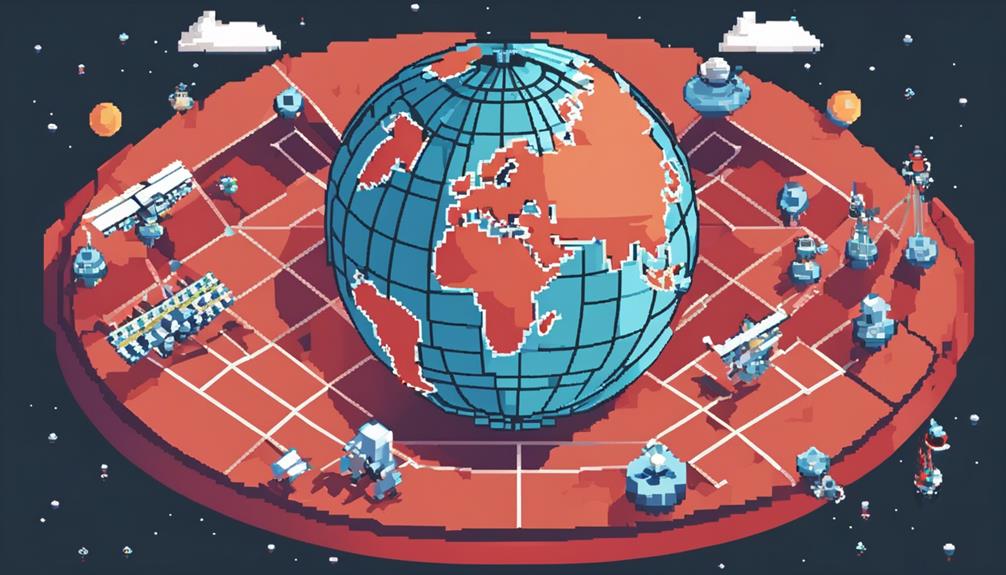The landscape of global satellite internet competition is undergoing a transformation marked by new entrants, technological advancements, and evolving market dynamics. With companies like Amazon venturing into the satellite internet domain, the industry is witnessing a shift towards innovation and enhanced connectivity. As satellite technology progresses and competition heightens, the future holds a myriad of possibilities that could reshape how we perceive and experience internet access on a global scale. Stay tuned to explore the intricate web of developments shaping the future of satellite internet competition and the implications it holds for the digital world.
Key Takeaways
- Emerging entrants like Amazon and SpaceX intensify competition
- Technological advancements drive innovation in satellite internet market
- Regulatory environment and economic factors shape competition dynamics
- Strategic partnerships enhance global coverage and network reliability
Emerging Players in Satellite Internet Competition

What are the implications of new entrants like Amazon, Telespazio, Vizocom, and SpaceX on the competitive landscape of the satellite internet industry? The introduction of these emerging players has significantly altered the dynamics of competition within the satellite internet market. Traditional providers are now facing intensified competition as these new entrants bring innovative technologies, services, and business models into the industry. Amazon's Project Kuiper, for instance, poses a formidable challenge to existing players by aiming to provide high-speed, affordable satellite internet services on a global scale.
Amazon's Project Kuiper has the potential to disrupt the market share of established satellite internet providers by offering a competitive alternative to consumers. Telespazio, Vizocom, and SpaceX are also making significant strides in expanding their presence and influence within the industry. Telespazio, with its expertise in satellite services, is leveraging its capabilities to capture a share of the growing market. Vizocom's focus on providing reliable and secure satellite connectivity solutions is attracting a diverse range of customers. SpaceX, with its Starlink project, is rapidly deploying satellites to create a constellation that can deliver high-speed internet to underserved areas.
Potential Collaborations Shaping the Industry
Collaborations between satellite companies and governmental entities are playing a pivotal role in shaping the trajectory of the global satellite internet industry. These partnerships are crucial for driving innovation, expanding global coverage, and enhancing connectivity options. Here are key points highlighting how these collaborations are shaping the industry:
- Enhanced Global Coverage: Collaborations between satellite companies and governments are instrumental in extending internet coverage to remote and underserved regions worldwide. By pooling resources and expertise, these partnerships can bridge the digital divide and bring connectivity to areas previously lacking access.
- Technological Advancements: Joint ventures in satellite technology are fostering the development of advanced networks that offer faster speeds, lower latency, and increased reliability. These technological advancements are reshaping the landscape of satellite internet services, making them more competitive with traditional terrestrial options.
- Competition and Partnerships: Alliances between satellite providers are driving competition within the industry, pushing companies to innovate and improve their offerings continuously. Through strategic partnerships, satellite companies can leverage each other's strengths to deliver more robust and efficient services to customers.
- Maximizing Connectivity: Cooperative efforts between satellite companies and governmental entities are essential for overcoming technical and regulatory challenges. By working together, stakeholders can maximize the potential of satellite internet services, ensuring widespread access and seamless connectivity for users around the globe.
Technological Innovations Driving Competition

Technological advancements in satellite design, launch capabilities, and ground infrastructure are revolutionizing the global satellite internet market. Companies are actively investing in cutting-edge technologies to enhance data transmission speeds, reduce latency, and provide more reliable connectivity. These innovations are reshaping the competitive landscape, driving a race among providers to offer superior services to a growing user base worldwide.
Satellite Tech Advancements
Significant advancements in satellite technology are propelling competition within the global internet connectivity market, driven by innovations in satellite design, launch capabilities, and communication protocols.
- High-throughput satellites and LEO constellations
- Next-generation satellite technology investments by companies like SpaceX and Amazon
- Focus on low-latency connections and high data speeds
- Diversification of services, offering new possibilities for global internet access
These advancements are reshaping the landscape of satellite internet services, pushing companies to enhance global connectivity, bridge the digital divide, and provide high-speed internet services worldwide. The future holds promise for satellite networks to play a crucial role in expanding global connectivity and transforming the way we access information and communicate on a global scale.
Market Competition Dynamics
The evolving landscape of the global satellite internet market is propelled by a wave of technological innovations that are redefining competition dynamics and driving advancements in connectivity solutions. Companies within the satellite industry are intensifying their focus on enhancing reliability, speed, and coverage to maintain their competitiveness in the global market. The introduction of new satellite constellations and ground infrastructure is significantly transforming the provision of satellite internet services worldwide. This shift is further catalyzed by the increased investment in research and development, fostering competition among satellite internet providers to deliver state-of-the-art solutions. Moreover, the emphasis on cost-effective and sustainable satellite technologies is a pivotal factor influencing the market dynamics of the global satellite internet sector, driving innovation and strategic advancements.
Market Trends Influencing Global Competition
The influx of new satellite companies and the projected market growth are key drivers shaping the competitive landscape of the global satellite internet industry. The market trends influencing global competition are:
- Growing Market Value: Predictions suggest a substantial rise in the satellite services market, with anticipated growth from $78.1bn in 2022 to $203.6bn by 2033. This surge indicates a significant expansion in the sector, fostering competition among providers.
- Entry of New Players: The industry is witnessing the entry of formidable competitors like Telespazio, Vizocom, SpaceX, and Amazon's Project Kuiper. These new entrants are reshaping the competitive environment and challenging established players.
- Compound Annual Growth Rate (CAGR): Market Statsville Group forecasts a CAGR of 9.1% from 2023 to 2033. This steady growth rate reflects the intensifying competition in the global satellite internet market, highlighting the increasing demand for reliable connectivity.
- Infrastructure Investments: Investments in satellite communication infrastructure and the emergence of hybrid satellite-terrestrial networks are fueling competition and innovation within the satellite industry. These developments are essential for improving global coverage, especially in remote areas, and bridging the digital divide by providing high-speed internet access to underserved regions.
These trends indicate a promising future for the satellite internet industry, driven by technological advancements and market dynamics.
Regulatory Environment Impacting Satellite Internet

Regulatory frameworks play a pivotal role in shaping the operational landscape and market dynamics of the global satellite internet industry, impacting deployment strategies and compliance adherence across diverse jurisdictions. The regulatory environment significantly influences satellite internet deployment by imposing constraints and requirements on satellite operators to comply with telecommunications laws specific to each region. Spectrum allocation conflicts between satellite operators and terrestrial services present challenges that can disrupt satellite internet operations, affecting service quality and coverage.
Economic considerations within the satellite internet market revolve around competition issues and affordability challenges. The regulatory environment plays a crucial role in ensuring fair competition among satellite operators while addressing affordability concerns to expand access to satellite internet services. Moreover, the social impacts of satellite internet involve considerations related to bridging the digital divide and providing connectivity to underserved communities. Environmental impacts, such as energy consumption and sustainability concerns, also necessitate regulatory frameworks that promote responsible practices among satellite operators to minimize their ecological footprint.
Balancing the social benefits of increased connectivity with the environmental responsibilities of sustainable technology deployment is essential for the long-term viability of satellite internet services. Regulatory bodies must continue to adapt to the evolving landscape of satellite internet technology to foster innovation while safeguarding against potential risks and ensuring equitable access for all.
Strategic Partnerships in Satellite Connectivity
Strategic partnerships in satellite connectivity play a vital role in fostering collaboration among industry players, enabling the sharing of expertise and resources to drive innovation and expand global internet access. These partnerships facilitate the pooling of technological capabilities and infrastructure to enhance satellite connectivity services, ultimately leading to improved coverage and performance. By forming alliances, companies like SpaceX, Amazon, OneWeb, and Telesat can combine their strengths to address connectivity challenges and meet the growing demands for high-speed internet access worldwide.
Key Partnership Benefits
Enhancing global satellite connectivity through strategic partnerships brings about significant improvements in coverage and service quality.
- Global Coverage: Collaborations between satellite companies and telecom providers expand coverage to previously underserved areas.
- Service Quality: Joint ventures enhance network reliability, ensuring a seamless and uninterrupted user experience.
- Innovation: Partnerships drive innovation in satellite internet technology, meeting the dynamic demands of the market.
- Cost-Effective Deployment: Alliances enable the efficient deployment of satellite infrastructure, reducing costs and facilitating broader reach.
These benefits not only foster industry growth but also enhance competitiveness within the satellite connectivity sector on a global scale.
Industry Collaboration Trends
Amid the evolving landscape of satellite connectivity, the trend of industry collaboration in strategic partnerships is shaping the future of global satellite internet competition. Satellite industry partnerships and telecom collaborations are driving joint ventures in satellite connectivity, leading to global coverage expansion and service quality improvement. These alliances foster innovation in satellite internet technology, ensuring cost-efficiency in the satellite industry while enhancing satellite network reliability. Industry collaborations also focus on improving interoperability in satellite services, creating seamless integration for users. By sharing resources, technology, and expertise, companies in the satellite industry are overcoming challenges and capitalizing on opportunities to provide cutting-edge services to consumers worldwide.
| Industry Collaboration Trends | Benefits |
|---|---|
| Global coverage expansion | Enhanced service quality |
| Innovation in satellite internet | Cost-efficiency in the industry |
| Satellite network reliability | Improved interoperability |
| Industry alliances in connectivity | Drive for seamless customer experience |
Future of Satellite Internet Pricing Strategies

The evolution of satellite internet pricing strategies is anticipated to prioritize affordability as a key driver for expanding market reach and customer engagement. Satellite internet providers are likely to implement various pricing models to cater to the diverse needs of consumers:
- Competitive Pricing Models: To differentiate services in a crowded market, providers may adopt competitive pricing strategies that offer value for money and attract customers seeking cost-effective solutions.
- Dynamic Pricing Structures: Future pricing structures may become more dynamic, adjusting based on factors such as data usage, speed tiers, and bundled services. This flexibility can ensure that customers pay for the services they need without overpaying for unused features.
- Promotional Deals and Discounts: Satellite internet companies might introduce promotional deals and discounts to incentivize new subscriptions and retain existing customers. These strategies can create a sense of urgency and drive adoption rates.
- Subscription-Based Plans: Offering subscription-based plans can provide users with the flexibility to choose connectivity options that align with their requirements. By providing scalable pricing structures, providers can accommodate varying consumer needs and promote long-term customer relationships.
User Experience and Customer Engagement
Enhancing user experience and customer engagement in the satellite internet industry involves focusing on interactive interface design and offering personalized service options. By investing in these aspects, companies can improve service quality and reliability to meet customer demands effectively. User feedback plays a crucial role in driving innovations that aim to provide fast, reliable connectivity and maintain a competitive edge in the market.
Interactive Interface Design
Interactive interface design plays a pivotal role in shaping user interactions and enhancing customer engagement within the satellite internet industry.
- User-friendly interfaces offer easy navigation and intuitive controls for accessing satellite internet services.
- Customizable features in interface design cater to diverse user preferences and needs in the satellite internet market.
- Engaging visual elements and interactive tools improve usability and satisfaction among satellite internet users.
- Data-driven approach in interface design optimizes user interactions and enhances overall customer experience in the satellite internet industry.
Personalized Service Options
In the realm of global satellite internet competition, the optimization of personalized service options is paramount for enhancing user experience and fostering customer engagement. Customized service plans tailored to individual needs drive customer satisfaction and loyalty in the satellite internet market. Providers leverage advanced analytics and data insights to offer personalized recommendations and solutions to users, ensuring a tailored approach. User-friendly interfaces and interactive tools empower customers to efficiently manage their satellite internet services, further enhancing the overall experience. Additionally, enhanced customer support and 24/7 assistance play a crucial role in providing a seamless and personalized satellite internet experience, contributing to increased satisfaction and retention rates. The strategic implementation of personalized service options is pivotal in meeting the evolving demands of users in the competitive global satellite internet landscape.
Sustainability Initiatives in Satellite Internet

Several satellite internet companies are actively engaging in sustainability initiatives to minimize their environmental impact and address concerns such as space debris and orbital congestion. SpaceX, a prominent player in the satellite industry, is spearheading sustainable practices for satellite deployment. The industry recognizes that addressing these challenges requires collaboration among space entities to develop effective solutions. Clear guidelines for satellite disposal are crucial to ensuring the long-term sustainability of satellite operations.
- Sustainability initiatives in satellite internet focus on minimizing environmental impact.
- Companies like SpaceX are working on sustainable practices for satellite deployment.
- Concerns about space debris and orbital congestion drive the need for sustainable solutions in satellite operations.
- Collaboration among space entities is essential to address sustainability challenges effectively.
Global Reach and Market Expansion
Efforts to extend global connectivity and broaden market presence through satellite internet services are driving significant expansion within the industry. Satellite internet providers, including companies like Starlink and Amazon, are strategically focusing on expanding their global reach to offer high-speed internet access to underserved regions, thus working towards bridging the digital divide. This market expansion is not only a means to reach new customer segments but also a response to the growing competition in the satellite industry. Companies are actively enhancing their global coverage capabilities to stay ahead in the race.
The deployment of satellite constellations in Low Earth Orbit is playing a pivotal role in revolutionizing the accessibility of internet services worldwide. This innovative approach not only improves the speed and reliability of connections but also enables broader coverage across the globe. As a result, the global satellite internet market is projected to experience significant growth, fueled by the expansion of services to new regions and customer segments. The emphasis on global reach and market expansion is reshaping the competitive landscape of the satellite internet industry, with companies striving to enhance their offerings and establish a strong foothold in the market.
Frequently Asked Questions
What Is the Future of Satellite Internet?
The future of satellite internet holds promise for network expansion, particularly in rural areas, with anticipated speed improvements. However, challenges such as reliability issues, pricing strategies, and data usage limits must be addressed. Ensuring global coverage and enhancing user experience are critical objectives, but regulatory hurdles and security concerns remain significant barriers to overcome. Advancements in technology will drive innovation in satellite internet services, reshaping the connectivity landscape on a global scale.
What Is the Future of Satellite Technology?
The future of satellite technology is poised to revolutionize space exploration, enhance connectivity solutions, expand networks globally, improve rural access, penetrate emerging markets, bolster infrastructure development, ensure global coverage, meet consumer demand, address regulatory challenges, and drive innovation trends. With advancements in satellite technology, we anticipate a transformative era where satellite systems play a pivotal role in shaping the digital landscape, fostering economic growth, and bridging connectivity divides across the globe.
Who Is the New Competitor of Starlink?
One of the new competitors challenging SpaceX in the satellite internet market is Amazon, through its Project Kuiper initiative. This development reflects the increasing competition within the industry, driven by a focus on technology innovation and expanding global connectivity. As market analysis suggests, the entry of Amazon into this space poses a significant challenge to established players like SpaceX, highlighting the dynamic nature of the satellite internet market.
What Is the Satellite Internet Market Forecast?
The satellite internet market is forecasted to experience robust growth driven by increasing consumer demand, technological advancements, and expanding global coverage. With a projected CAGR of 9.1% from 2023 to 2033, the industry is expected to witness significant expansion. This growth is supported by investments in communication infrastructure, innovative satellite technologies, and competitive pricing strategies. Network reliability, satellite bandwidth, and customer satisfaction will play pivotal roles in shaping market dynamics.
